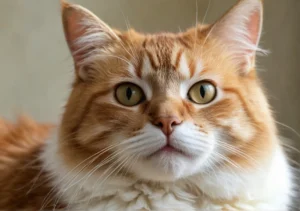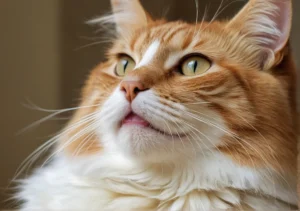Cats are known for squeezing through tiny spaces effortlessly, sometimes even fitting through openings the size of their heads. But why can cats pull off this seemingly impossible feat? Let’s find out.
Anatomy of a Cat’s Skull
Have you ever wondered why cats can squeeze through openings the size of their head? It all comes down to their unique anatomy. A cat’s skull is specially designed to allow for this impressive feat. Their skulls are small and round, with large eye sockets and elongated jaw bones that give them the flexibility to contort their bodies into tight spaces. Additionally, cats have collapsible rib cages that can compress, making them even more agile when navigating through narrow openings.
Flexible Skeleton
In addition to their skull structure, a cat’s skeleton is another key factor in their ability to fit through small spaces. Cats have an incredibly flexible spine with extra vertebrae compared to other animals. This allows them to twist and turn their bodies with ease, maneuvering through tight spots effortlessly. Furthermore, cats have no collarbone, which gives them even more flexibility to compress their bodies to pass through narrow gaps.
- Bonus Insight: Cats also have powerful shoulder muscles that allow them to push themselves through openings, utilizing both their skeletal flexibility and muscular strength to navigate through spaces with precision.
Remember, the next time you see your feline friend effortlessly squeeze through a tiny opening, you can attribute their remarkable ability to their adapted anatomy and flexible skeleton.
Collapsible Body
Did you know that a cat’s body is like a master of flexibility? Yes, cats have a unique ability to collapse and compress their bodies, allowing them to squeeze through tight spaces effortlessly. Their bones are more flexible compared to other animals, and they lack a collarbone, giving them the advantage of contorting their bodies without any hindrance. This flexibility is especially handy when it comes to slipping through openings the size of their head. So, next time you marvel at your feline friend effortlessly squeezing through a small opening, remember, it’s all thanks to their amazing collapsible bodies.
Whisker Sensitivity
A cat’s whiskers are not just there for show; they serve a significant purpose in determining whether they can fit through a particular space. These sensitive whiskers are roughly as wide as a cat’s body, acting as a natural measuring tape. When a cat approaches an opening, its whiskers can tell if it’s wide enough for them to pass through without getting stuck. If the whiskers don’t brush against the sides, the cat knows it can confidently glide through the gap. It’s like having built-in sensors that guide them through narrow escapes with a whisker’s breadth of space.
Additional Unique Insight:
Here are some other interesting facts about cat whiskers: 1. Whiskers are highly sensitive tactile hairs embedded deep in a cat’s body, connected to a sensitive nervous system. 2. Whiskers help cats navigate their surroundings in the dark by detecting changes in air currents and objects nearby. 3. Whiskers are also mood indicators; when a cat feels threatened or scared, their whiskers might move back, signaling their emotions. So, it’s not only a measuring tool but a communication device too.
Hunting Instincts and Escape Strategies
Cats possess incredible hunting instincts that have been honed over thousands of years. Their ability to fit through small openings the size of their head is directly linked to these instincts. When a cat squeezes through a tight space, it’s often mimicking the movements it would use while stalking prey. By contorting their bodies and slipping through narrow gaps, cats can access hiding spots or chase down elusive prey with ease.
Additionally, cats have natural escape strategies that come into play when faced with danger. Being able to fit through small openings allows them to evade predators or navigate through challenging terrain. This adaptability gives them a significant advantage in the wild, where quick reflexes and agility are essential for survival.
Evolutionary Adaptations
The remarkable agility and flexibility of cats can be attributed to their evolutionary adaptations. Through centuries of natural selection, cats have developed unique skeletal structures and muscular systems that allow them to move with precision and grace. Their bones are incredibly flexible, especially in the spine, which enables them to twist, bend, and compress their bodies to fit through tight spaces.
Moreover, cats have retractable claws that aid in gripping surfaces and propelling themselves forward. This evolutionary trait enhances their climbing abilities and overall dexterity. Combined with their powerful hind legs and sharp senses, cats have become masters of navigating various environments with ease.
Unique Insight: Cats also have whiskers that play a crucial role in helping them determine if they can fit through a particular opening. These specialized sensory organs are highly sensitive and can detect even the slightest changes in their surroundings, providing valuable information about the size and shape of a space before attempting to pass through. Whiskers act as a built-in measuring tool, allowing cats to assess potential obstacles and make split-second decisions based on their findings.
Fun Facts About Cats
Cats are notorious for their ability to squeeze through tight spaces, often baffling us with their agility. So, why can cats fit through openings the size of their heads? Well, it all boils down to their unique anatomy. A cat’s skull is composed of several small, flexible bones connected by elastic ligaments. This allows them to flatten their skulls and squeeze their bodies through narrow spaces with ease. It’s like they’re built for sneaking into those nooks and crannies!
But here’s a mind-blowing fact for you: a cat’s whiskers are roughly as wide as its body. These sensitive sensors help cats gauge whether they can fit through an opening without getting stuck. It’s like having built-in measuring tools! So, next time you wonder how your cat managed to wiggle through a tiny gap, remember it’s all in the whiskers.
And don’t be surprised if your cat seems to magically appear in unexpected places. These stealthy creatures are expert contortionists and love to explore every nook and cranny in your home. Just another day in the life of a cat owner!
Tips for Cat Owners
Creating a safe environment for your beloved feline friend is crucial to their well-being. With their knack for wriggling into tight spots, it’s essential to safeguard your home to prevent any mishaps. Start by securing windows and any small openings that your curious cat might attempt to slip through. Mesh screens or pet-safe barriers can be a lifesaver in keeping your cat safe indoors.
Another vital tip is to provide plenty of vertical space for your cat to explore. Cats love to perch up high, surveying their kingdom below. Invest in cat trees or shelves to satisfy their climbing instincts and give them a safe space to observe their surroundings. This not only keeps them entertained but also provides valuable mental stimulation.
And here’s a pro tip: consider microchipping your cat, even if they are primarily indoor pets. Cats are known escape artists, and having a microchip greatly increases the chances of being reunited with your furry friend if they ever get lost. It’s a small investment for priceless peace of mind.
Remember, a happy and safe cat is a joy to have around. By understanding their unique abilities and taking preventive measures, you can create a harmonious environment where your feline companion can thrive.
Alex, a passionate animal lover, has experience in training and understanding animal behavior. As a proud pet parent to two dogs and three cats, he founded AnimalReport.net to share insights from animal experts and expand his knowledge of the animal kingdom.




